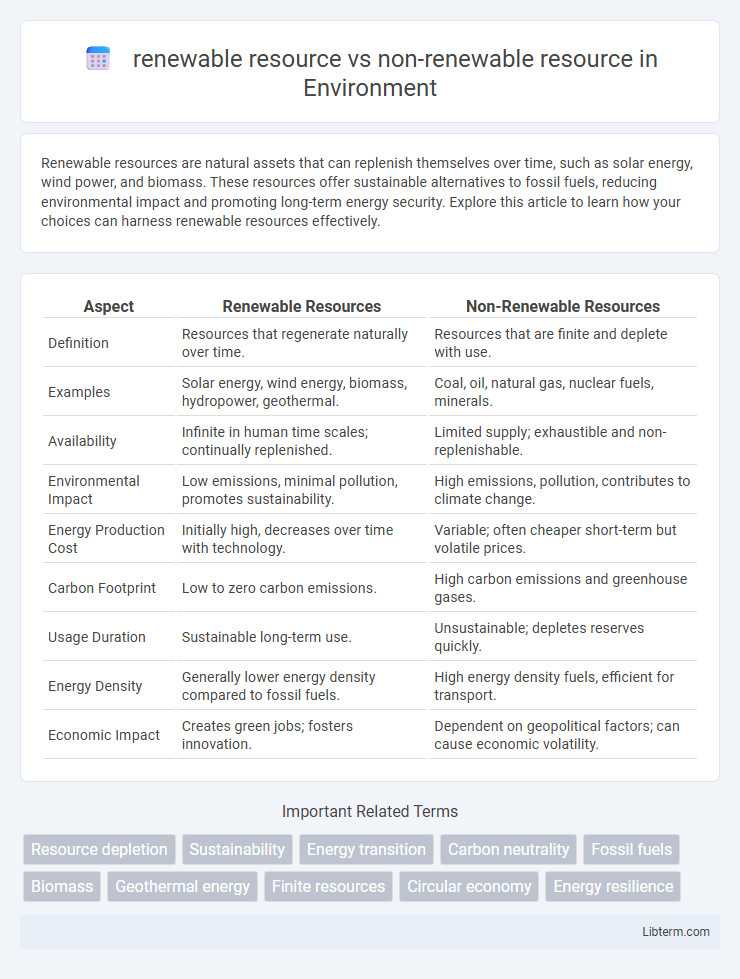Renewable resources are natural assets that can replenish themselves over time, such as solar energy, wind power, and biomass. These resources offer sustainable alternatives to fossil fuels, reducing environmental impact and promoting long-term energy security. Explore this article to learn how your choices can harness renewable resources effectively.
Table of Comparison
| Aspect | Renewable Resources | Non-Renewable Resources |
|---|---|---|
| Definition | Resources that regenerate naturally over time. | Resources that are finite and deplete with use. |
| Examples | Solar energy, wind energy, biomass, hydropower, geothermal. | Coal, oil, natural gas, nuclear fuels, minerals. |
| Availability | Infinite in human time scales; continually replenished. | Limited supply; exhaustible and non-replenishable. |
| Environmental Impact | Low emissions, minimal pollution, promotes sustainability. | High emissions, pollution, contributes to climate change. |
| Energy Production Cost | Initially high, decreases over time with technology. | Variable; often cheaper short-term but volatile prices. |
| Carbon Footprint | Low to zero carbon emissions. | High carbon emissions and greenhouse gases. |
| Usage Duration | Sustainable long-term use. | Unsustainable; depletes reserves quickly. |
| Energy Density | Generally lower energy density compared to fossil fuels. | High energy density fuels, efficient for transport. |
| Economic Impact | Creates green jobs; fosters innovation. | Dependent on geopolitical factors; can cause economic volatility. |
Introduction to Renewable and Non-Renewable Resources
Renewable resources, such as solar, wind, and biomass, are naturally replenished on a human timescale, providing sustainable energy solutions that reduce environmental impact. Non-renewable resources, including coal, oil, natural gas, and minerals, exist in finite quantities and are depleted faster than they can naturally regenerate, leading to resource scarcity and environmental degradation. Understanding the distinction between renewable and non-renewable resources is crucial for developing effective energy policies and promoting long-term environmental sustainability.
Defining Renewable Resources
Renewable resources are natural assets that can replenish themselves naturally over short periods, such as solar energy, wind, and biomass. These resources provide sustainable energy solutions by continuously regenerating without depleting the Earth's reserves. Unlike non-renewable resources like fossil fuels and minerals, renewable resources offer lower environmental impact and long-term availability for energy production.
Defining Non-Renewable Resources
Non-renewable resources are natural materials that cannot be replenished on a human timescale, including fossil fuels like coal, oil, and natural gas, as well as minerals and metals such as gold and uranium. These resources form over millions of years through geological processes, making their extraction finite and environmentally impactful. Unlike renewable resources, non-renewable resources contribute significantly to greenhouse gas emissions and environmental degradation when consumed.
Key Differences Between Renewable and Non-Renewable Resources
Renewable resources such as solar, wind, and hydropower regenerate naturally and are sustainable over time, whereas non-renewable resources like coal, oil, and natural gas are finite and deplete with use. Renewable energy sources emit fewer greenhouse gases and have a lower environmental impact compared to the high carbon emissions and pollution associated with extracting and burning fossil fuels. The economic viability of renewable resources improves with technological advancements, while non-renewable resources face increasing extraction costs and supply constraints.
Types of Renewable Resources
Solar, wind, hydro, geothermal, and biomass are the main types of renewable resources, each harnessing natural processes that replenish continuously. Solar energy captures sunlight through photovoltaic cells, while wind energy uses turbines to convert air currents into electricity. Hydropower generates energy from flowing water, geothermal exploits Earth's internal heat, and biomass derives fuel from organic materials, all contributing to sustainable energy production.
Types of Non-Renewable Resources
Non-renewable resources include fossil fuels such as coal, oil, and natural gas, which formed over millions of years from ancient organic matter. Other types encompass nuclear fuels like uranium and thorium, used in energy production due to their high energy density. These resources are finite and deplete with extraction, contrasting sharply with renewable resources that replenish naturally over short periods.
Environmental Impact Comparison
Renewable resources such as solar, wind, and hydropower produce minimal greenhouse gas emissions and reduce air and water pollution, significantly lowering their environmental footprint compared to non-renewable resources like coal, oil, and natural gas, which release high levels of carbon dioxide, sulfur dioxide, and nitrogen oxides. The extraction and combustion of fossil fuels contribute to habitat destruction, acid rain, and climate change, while renewable resource systems promote sustainability by harnessing naturally replenished energy with limited ecological disturbance. Lifecycle assessments confirm that renewable energy technologies generate substantially fewer pollutant emissions and have a smaller carbon footprint over their operational lifetime than traditional non-renewable energy sources.
Economic Implications of Resource Use
Renewable resources, such as solar and wind energy, offer long-term economic benefits by reducing dependency on finite materials and lowering operational costs through sustainable practices. Non-renewable resources like coal, oil, and natural gas often incur higher economic risks due to price volatility, depletion rates, and environmental compliance costs. Transitioning to renewable resources can stimulate job creation in emerging industries while mitigating financial liabilities associated with pollution and resource scarcity.
Sustainable Management and Future Prospects
Renewable resources, such as solar and wind energy, offer sustainable management through their inherent ability to replenish naturally, reducing environmental impact and promoting energy security. In contrast, non-renewable resources like fossil fuels face depletion risks and contribute significantly to greenhouse gas emissions, challenging long-term sustainability. Future prospects emphasize transitioning to renewable energy systems, improving energy efficiency, and developing advanced technologies for resource conservation and environmental protection.
Conclusion: The Importance of Resource Choices
Choosing renewable resources over non-renewable resources is critical for sustainable development and environmental preservation. Renewable resources, such as solar and wind energy, offer long-term availability and reduced carbon emissions compared to finite fossil fuels like coal and oil. Prioritizing renewable energy supports climate change mitigation and ensures energy security for future generations.
renewable resource Infographic

 libterm.com
libterm.com